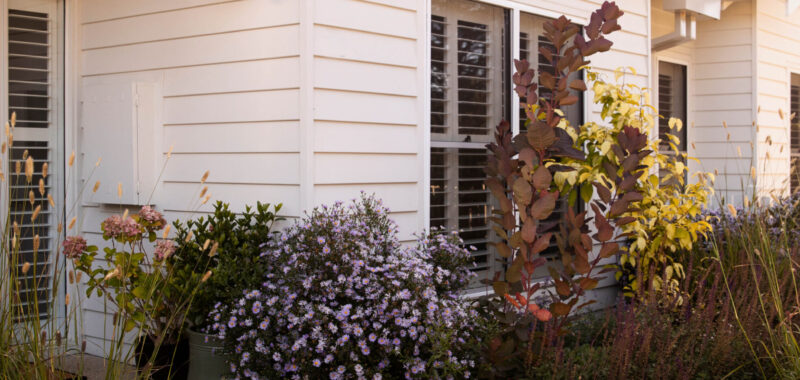When renowned garden designer Tim Pilgrim took on the project of transforming this tiny Macedon Ranges property, he was faced with a ‘blank canvas’ of sorts.
While the terrace house in Woodend was newly built, it had a quaint charm to it thanks to the cottage-style facade and row of nandina domestica (sacred bamboo) and a lagerstroemia (crepe myrtle) that had been planted in the front yard.
But the narrow south-facing side of the house was purely dirt, and the back yard came with a lawn but not much else.
Given his expertise dealing with natural edible and cottage-style gardens, the Woodend project was like bread and butter for Tim — despite the challenges that came with its size.
‘We had 140 square metres to work with and used every square millimetre,’ he says. ‘We had to leave space for a lawn for our client’s dog to play on, and once the deck size was established we were left with under 100 square metres for the rest.’
However he made do with the small scale of the yard, ensuring no space was wasted. This included fitting in a few espalier fruit trees to create a mini orchard, plus three raised steel vegetable beds, and some climbing plants to occupy any walls or fences where possible — such as trachelospermum jasminoides (star jasmine) which cover a rusted frame that will eventually hide the neighbouring garage wall once the flowers bloom.
‘We used height in the planting to give the garden scale with the neighbouring trees and to make the relatively narrow beds feel deeper than they were,’ Tim explains. ‘We planted more sporadically as opposed to planting in larger groups which can limit your planting palette in small gardens.
His client also had an affinity for English-style gardens and David Austin roses. Taking inspiration from UK gardens like Highgrove, Kensington Palace and Hidcote Manor, Tim filled the Woodend yard with various roses in softer hues to help them pop — including rosa a shropshire lad (English roses), rosa boscobel (David Austin roses) and rosa ‘summer song’ austango (summer song roses).
Pastel shades were incorporated throughout the remaining garden to help highlight some of the deeper, richer coloured roses (like the summer song). These plantings were also staggered to ensure there would always be something flowering at any given time of the year.
In summer, agastache (sweet lili) and achillea (cloth of gold) bloom to reveal vibrant bursts of pink and golden yellow, while pops of purple are seen from the nepeta racemosa (catnip) and salvia nemorosa (caradonna) flowers when they blossom in late spring.
The garden is particularly lively in autumn thanks to the violet symphyotrichum cordifolium (aster ‘wood’s blue’) plantings, pastel pink anemone huphensis (Japanese anemone) flowers, and vibrant yellow helenium autumnale (common sneezeweed) flowers.
Now in its first full bloom since completion, the site can be broken down into three core spaces: the front garden, which frames the facade of the house and lines the entry path to the front door; the minimalist side garden or ‘palate cleanser’ as Tim describes it; and the flourishing rear garden including the edible plants and a small bird pond, all surrounding an entertaining deck and manicured lawn.
Despite the detail found in the front and rear gardens, however, Tim says his favourite part is the side garden — a green transition between the other gardens, he says.
‘We added a winding path with stepping stones to help slow you down through this space and add pockets of deeper beds for planting,’ he adds. ‘We exercised restraint which I’m not very good with most of the time, preferring to take a maximalist approach.
‘I call it the palate cleanser between the much more blousy front and back gardens. Green on green with repeated contrasting form.’

